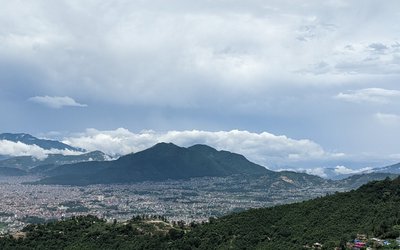Women’s role to nature conservation has always been highlighted for decades. As women are often the primary users and managers of resources, their knowledge of diverse species is huge (Byers &Sainju, 1994), (Singh, 2020). It has been said that women have an intrinsic relationship with nature, and that there can be differential perceptions of men and women towards nature. Livelihood of most rural women in Nepal and across the world depends on natural resources, and under its vicinity they play the roles of forest gatherers, collectors of water, farmers, herders, health care givers, cultivators, seeds preservers and conservationists (ICIMOD , 2012). Therefore, they have extensive knowledge about harvesting time, regeneration methods, as well as efficient resource usage. They are the population that spends their days with water and forest resources, and thereby the benefactors as well as dependents of nature. As an evidence, all women forestry groups in Nepal and India had better forest regeneration and canopy growth, even in the cases of starting with much more degraded lands (Agarwal, 2009 ). This has been attributed to their knowledge about forest species, products extraction as well as a closer cooperation among the women.
While women are the caretakers of households and nature, they are also often the most vulnerable groups to the impacts of environmental degradation. Different studies show that people perceive higher threat to women arising out of environmental and climate crisis (Ministry of Science Technology and Environment , 2015)(ICIMOD , 2012)(Community Forestry Division, Department of Forests, Government of Nepal,, 2018). As they are one of the most heavily resource dependent and often marginalized groups, loss of biodiversity would mean lack of food and livelihood security for them (ICIMOD , 2012). Degradation of forests also leads to increase in women’s workload, increasing the time it takes for water, firewood and other biological resource collections (ICIMOD , 2012).
There have been studies that show that involvement of women in conservation activities increases its efficiency, due to their knowledge on land use, and about plants. Also, women have more varietal selection than men because of this knowledge, therefore aiding in plantations of variety of plants (Momsen, 2007). Objectives for women empowerment has been included in all conservation strategies, as the vulnerability of women is highly acknowledged in Nepal.
However, the involvement of women in conservation sector has been very low in case of Nepal. Study in protected areas of Nepal showed that out of 1155 staffs in national parks and wildlife groups, only 175 were female, and there were no female in vital executive positions of Conservation Area Management Councils and Buffer Zone Management Committees (Maharjan, et al., 2020). Similarly, there were only about 4% female members occupying strong positions in buffer zone and conservation user groups. Also, in Department of National Parks and Wildlife Conservation, 15% of employee were women. This also coincides with similar cases from across the globe, where participation of women in conservation sector is lacking (Kaeser et al. 2018). This stands true decades from 1991 when the Community Forestry Guideline promulgated a compulsion to have 33% women representation in community forest user groups (Maharjan, et al., 2020). There is a lack of women to compete, participate meaningfully, and negotiate with the national park or council body to ensure the budget is responsive to gender needs (WWF Nepal, 2015).
Study also shows that in most community forests in Nepal, groups with all-women executive committee received smaller forest areas which were often more degraded plots than given to groups with mixed gender executive committee; and even this was received by the women after going through hardships to prove to unbelieving authorities that they were capable enough to manage the forest (Agarwal, 2009 ). Lack of institutional management done by women in the past has further led to the vicious circle where they lack experience, and are therefore not trusted by authorities, which again prevents them from having any institutional experience.
There are various reasons behind the limited number of women in the forefront of conservation. In the case of Nepal, women are still underrepresented in almost all the sectors, including conservation. This has been because of lack of gender sensitive facilities, equal opportunities and treatment, including proper rules and regulations. Women reportedly get harassed by males during patrolling around the forest, and are insecure in doing so. This includes verbal harassment and gender insensitive talks and behaviors. There are several cultural barriers in place too. During menstruation, many water bodies, places, plants and animals are barred from women, therefore affecting their work. Most of the times these restrictions are taken as incapability of women for professional performance, thereby barring them from participation during decision making processes. Having a bigger number of male representation further limits the already repressed voices of women. Family restrictions of women’s participation outside the house is also a major barrier.
Despite the high involvement of women in environmental, agricultural, and household management, women have often been barred from many socio-economic activities in the nation, and indigenous women are excluded not only because they are women but also because of their caste. Therefore, gender based conservation efforts has been credited to be important to bring about social justice too. In regards to conservation initiatives in buffer zone, security and health has come to play as barriers for comfortable women involvement, for which government and agencies must have proper rules and frameworks for their assistance. The Forest Sector Strategy 2016-2025 has included priority for inclusivity by promoting gender equity in all forestry related organizations, and also supports formation of women with Community Forest User Groups which has been one of the most successful approaches to include women participation.
During many integrated conservation activities, livelihood improvement programs are carried out by organizations and agencies. The communities who gain access to these programs have wide array of benefits including micro-finances, decision making ability, and opportunity for income. Therefore to be unable to participate in these programs by women would mean inability to make use of opportunities to contribute their knowledge and better their lives. Under representation of women also means unequal distribution of rights and benefits. This is even worse for indigenous women, whose so called lower stature in the community is an even further barrier to leap from.
There has been a very slow progress of women involvement in conservation, and the recent Covid pandemic is posing a further threat to the conservation activities. According to the Department of National Parks and Wildlife Conservation (DNPWC) and WWF Nepal, there has been a sharp rise in human disturbances in the national parks after the first lockdown in March and April. There were rise in illicit logging and harvesting, which has reportedly been tripled compared to the months before the lockdown (WWF, 2020). Similarly, the cost of conservation activities is very high, and the pandemic has halted majority of funding, due to which Nepal is losing its momentum in conservation efforts. There is reduction and halts in research based activities and in patrolling because of lack of funding. This is especially true for small scale organizations with limited funding. The Society for Conservation Biology Nepal also stated that it had to halt its rhino count program and bring down and postpone many conservation efforts.
Nepal is also highly dependent on nature based tourism, and due to the lockdown, tourism has come down to zero from million. This has also caused lack of revenue to many national parks and conservation areas, which runs from monetary revenues of tourism. This has also caused economic deprivation for number of local communities that depend on tourism.
This has posed threat not only to the conservation agendas, but also on the livelihood of people, and women who are dependent on forest resources. As IUCN states, the growing recession after the pandemic will cause countless rural communities closer to the hotspots to turn back to wildlife consumption if other survival options do not remain (IUCN, 2020).
For a country with commendable community forestry success, local people involvement should continue to be a huge resource and opportunity for the future, and thereby consideration of women participation is a necessity. Nepal is also an example for how top down approach to conservation fails, whereas community participation helped in forest regenerations (Bajracharya, et al., 2007). Integrated landscape conservation that is being done in various parts of Nepal has livelihood improving activities, which women can take benefit from in improving their social standing and drawing knowledge and support from their social networks. In consideration to the pandemic these activities might be halted, posing threat of causing hardships to the women. Resuming these activities should be a priority to ensure benefit sharing to the women.
When it comes to indigenous women in buffer zones of national parks, consideration should be taken on how their knowledge attributes to conservation, but also how their rights to resources for decent livelihood can be ensured. For many of these women, they have to travel long distances to get basic amenities such as water, fodder and fuelwood. Most of them are also frontiers in agricultural activities. As such, targeting women during conservation initiatives has aided in empowering women while utilizing the knowledge resources that they have.
Integrated conservation while being effective in tackling the transboundary global concerns of biodiversity loss and climate change faces criticism of being unable to comply with the needs of local people, especially vulnerable indigenous, marginalized people and women. It faces backlash of having failed the need of indigenous people’s access to resources and livelihood development. There has been instance of violence against the indigenous people, evicting them from their land (Sunuwar, 2020), and differential vulnerability of indigenous women as pointed out by National Indigenous Women’s Federation (NIWF). However, different gender responsive conservation programs has also been able to improve the livelihood of women while also increasing their influence, resource management and negotiating capacity and giving their equal rights and benefits to forest resources. Future conservation plans should be more focused on the livelihood of these remote indigenous people, as their dependence on natural resource makes them more vulnerable, and being landless and economically backward impacts them from unforeseen events the most. While trends suggest a rise in exploitation after recession, it becomes important to continue vigilance to the conservation activities by the Government, while working for green solutions and economic recovery efforts that support communities.
Anuska Joshi from Nepal, graduate in sustainability science from United Nations University - Institute for Advanced Study of Sustainability.
References
Agarwal, B., 2009 . Gender and Forest Conservation: The Impact of Women's Participation in Community Forest Governance. Ecological Economics , pp. 2785-2799.
Bajracharya, S. B., Gurung, G. B. & Basnet, K. B., 2007. Learning from Community Participation in Conservation Area Management. Journal of Forest and Livelihood .
Byers, E. & Sainju, M., 1994. Mountain ecosystem and women: Opportunities for sustainable development and conservation. Mountain Research and Development , pp. 213 - 228.
Community Forestry Division, Department of Forests, Government of Nepal,, 2018. Database of the Community Forest User Groups in Nepal, s.l.: Community Forestry Division, Department of Forests, Government of Nepal,.
ICIMOD , 2012. Gender and Biodiversity Management in the Greater Himalayas: Towards Equitable Mountain Development , s.l.: ICIMOD; GIZ.
IUCN, 2020. COVID-19 and a new form of conservation. [Online].
Maharjan, S., Shrestha, B. P. & Rana, S. A., 2020. Women in Protected Area and Buffer Zone Management. s.l.:s.n.
Ministry of Science Technology and Environment , 2015. Indigenous and Local Knowledge and Practices for Climate Resilience in Nepal, Mainstreaming Climate Change Risk Management in Development, Kathmandu, Nepal: Ministry of Science Technology and Environment .
Momsen, J., 2007. Gender and Biodiversity: A New Approach to Linking Environment and Development. Geography Compass, pp. 149 - 162.
Singh, S., 2020. Indigenous health management of Tharu tribals in the eastern part of Parsa, Nepal. Jounal of Pharmacognosy and Phytochemistry.
Sunuwar, D. K., 2020. Violence against Chepang Peoples in Nepal Sparks Outrage at National Park Authorities and Conservation Movement. s.l.:cutural survival.org .
WWF Nepal, 2015. Gender Responsive and Inclusive Conservation , Kathmandu, Nepal: WWF Nepal.
WWF, 2020. Rising Pressures on Nepal Tiger Habitat. [Online]
Available at: https://tigers.panda.org/news_and_stories/stories/rising_pressure_on_nepal/













